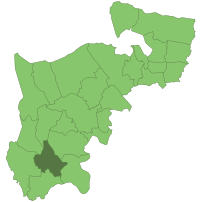Feltham Urban District facts for kids
| Feltham | |
| Motto: In Unitatem Coemus (Let us go forward together) | |
 Feltham within Middlesex in 1961 |
|
| Geography | |
| Status | Urban district |
| 1894 area | 1,790 acres (7.2 km2) |
| 1965 area | 4,925 acres (19.9 km2) |
| History | |
| Created | 1904 |
| Abolished | 1965 |
| Succeeded by | London Borough of Hounslow |
Quick facts for kids Demography |
|
|---|---|
| 1901 population | 4,534 |
| 1961 population | 51,047 |
Feltham was a special local government area called an urban district. It was located in the old county of Middlesex, England. This district existed from 1904 until 1965.
When Middlesex was changed in 1965, Feltham became part of Greater London. It was the main local body for the area known as Feltham. Before 1904, this area was part of the Staines Rural District.
In 1930, two other areas were added to Feltham Urban District. These were East Bedfont (which included Hatton) and Hanworth.
The Feltham Urban District was officially ended in 1965. It then became part of the new London Borough of Hounslow. This was due to the London Government Act 1963.
Feltham's Coat of Arms
Feltham Urban District had its own special symbol called a coat of arms. It was given to the district in 1945. A coat of arms uses pictures and colors to tell a story about a place.
The design had a wavy line. This line, along with the silver and blue colors, stood for two important rivers. These were the Duke of Northumberland's River and the Longford River. Both rivers bring water from the River Colne to famous places like Syon House and Hampton Court Palace.
Two black stripes on the shield represented railway lines. These showed how important Feltham was to the railway system. Feltham had a very large train yard called the Feltham marshalling yard.
A Tudor rose was included to remember the Tudor period. This was a time when kings and queens like Elizabeth I lived. It is believed that Elizabeth I spent some of her childhood at Hanworth Manor.
A peacock on the coat of arms represented the famous topiary peacocks. These are peacocks shaped from bushes in the gardens of St Mary's Church in Bedfont. They are a well-known local symbol.
A winged sword was also part of the design. This symbol stood for London Airport. It also showed Feltham's strong connection to making airplanes. The sword also referred to an army supply depot and an old sword-making mill.
Small black circles, called gunstones, also referred to the army depot. They also reminded people of the old powder mills in the Crane Valley. A hawthorn plant was included for the Spelthorne Hundred, which was an old division of land.
Finally, an eagle on the coat of arms had two meanings. It represented air traffic, like planes flying. It also referred to old Roman roads that went through the area. These roads connected London to places like Bath and Calleva Atrebatum.
Areas in Feltham Urban District
The Feltham Urban District was made up of different local areas called civil parishes.
- East Bedfont Civil Parish (joined in 1930)
- Feltham Civil Parish (was part of the district the whole time)
- Hanworth Civil Parish (joined in 1930)

